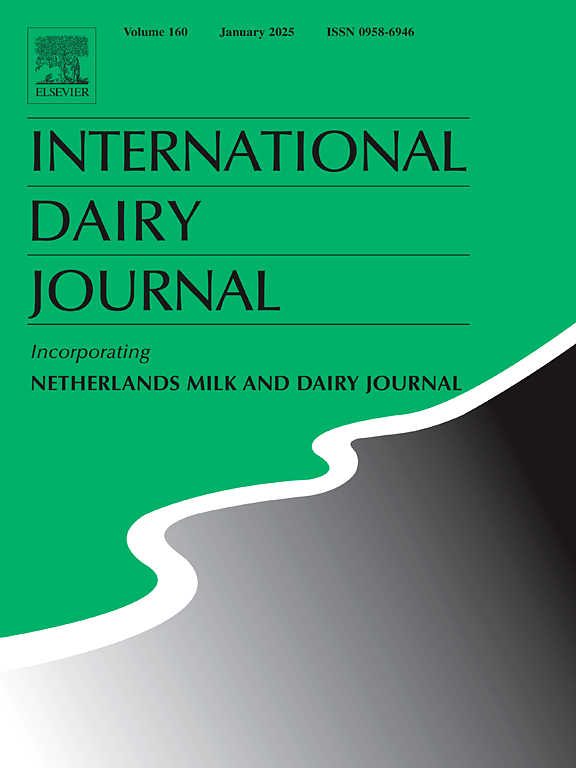羊奶开菲尔的脂肪酸谱、共轭亚油酸(CLA)含量、微生物学特性和感官特性的比较研究
IF 3.1
3区 农林科学
Q2 FOOD SCIENCE & TECHNOLOGY
引用次数: 0
摘要
本研究旨在揭示用羊奶和牛奶进行谷物或发酵剂培养生产的开菲尔的详细脂肪酸谱、共轭亚油酸(CLA)水平、微生物学和感官特性。使用不同种类的牛奶、谷物或发酵剂对结果有显著影响。发酵剂生产的乳酸菌的乳酸球菌和乳酸菌计数均高于谷物生产的乳酸菌计数,而酵母计数在谷物生产的样品中最高(p <;0.05)。羊乳开非尔乳酸菌数量高于牛奶开非尔(p <;0.05)。羊乳kefirs的多不饱和脂肪酸(PUFA)、CLA和Omega-3含量高于牛奶kefirs (p <;0.05)。此外,谷物的生产提高了牛奶开非尔的PUFA值以及羊乳和牛奶开非尔的CLA含量。羊奶kefirs的血栓形成指数和Omega-6/Omega-3比值在整个贮藏过程中均低于牛奶(p <;0.05)。羊奶kefirs的动脉粥样硬化指数也低于牛奶样品,直到储存中期。从感官上看,牛奶kefirs在味道和总体可接受性方面得分较高,而羊奶kefirs具有更好的质地。羊奶通过增加PUFA、CLA和Omega-3的含量,提高了克非尔的营养质量和健康益处。谷物的使用也增加了CLA的水平,这在牛奶和羊奶中都有很多健康益处。本文章由计算机程序翻译,如有差异,请以英文原文为准。

Fatty acid profile, conjugated linoleic acid (CLA) content, microbiological and sensory properties of kefir produced from sheep milk using kefir grains and starter culture in comparison with the respective kefir from cow milk
The present study aimed to reveal the detailed fatty acid profile, conjugated linoleic acid (CLA) levels, and microbiological and sensory properties of kefirs produced by grain or starter culture using sheep milk compared to cow milk.
The use of different milk types, grains, or starter cultures significantly affected the results. Production with starter culture increased both lactococci and lactobacilli counts of kefirs compared to the production by grain while the highest counts of yeast were enumerated in the samples produced with grain (p < 0.05). Sheep milk kefir had a higher count of lactobacilli than cow milk kefir (p < 0.05). The levels of polyunsaturated fatty acids (PUFA), CLA and Omega-3 of sheep milk kefirs were higher than the cow milk kefirs (p < 0.05). In addition, the production of grain increased the PUFA value of cow milk kefir and the CLA content of both sheep and cow milk kefirs. The thrombogenic indices and the Omega-6/Omega-3 ratios of sheep milk kefirs were lower than those of cow milk throughout the storage (p < 0.05). The atherogenic indices of sheep milk kefirs were also found lower than the samples from cow milk until the middle of storage. Sensorially, cow milk kefirs had higher scores in terms of taste and overall acceptability, whereas sheep milk kefirs had better texture.
Sheep milk improved the nutritional quality and health benefits of kefir by increasing the levels of PUFA, CLA and Omega-3. The use of grains also increased the levels of CLA, which has many health benefits, in both cow and sheep milk kefirs.
求助全文
通过发布文献求助,成功后即可免费获取论文全文。
去求助
来源期刊

International Dairy Journal
工程技术-食品科技
CiteScore
6.50
自引率
9.70%
发文量
200
审稿时长
49 days
期刊介绍:
The International Dairy Journal publishes significant advancements in dairy science and technology in the form of research articles and critical reviews that are of relevance to the broader international dairy community. Within this scope, research on the science and technology of milk and dairy products and the nutritional and health aspects of dairy foods are included; the journal pays particular attention to applied research and its interface with the dairy industry.
The journal''s coverage includes the following, where directly applicable to dairy science and technology:
• Chemistry and physico-chemical properties of milk constituents
• Microbiology, food safety, enzymology, biotechnology
• Processing and engineering
• Emulsion science, food structure, and texture
• Raw material quality and effect on relevant products
• Flavour and off-flavour development
• Technological functionality and applications of dairy ingredients
• Sensory and consumer sciences
• Nutrition and substantiation of human health implications of milk components or dairy products
International Dairy Journal does not publish papers related to milk production, animal health and other aspects of on-farm milk production unless there is a clear relationship to dairy technology, human health or final product quality.
 求助内容:
求助内容: 应助结果提醒方式:
应助结果提醒方式:


